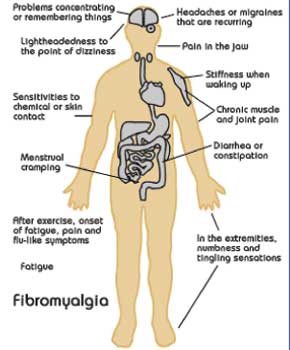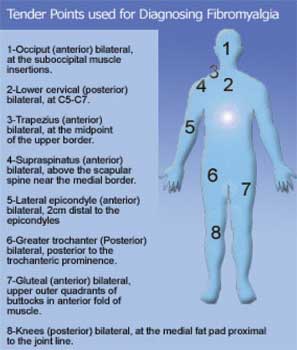The word fibromyalgia means pain ('algia') coming from the muscles ('my') and fibrous tissues ('fibro') such as tendons and ligaments. Most people with fibromyalgia also have other symptoms in addition to the pains - see below. Therefore, fibromyalgia is sometimes called fibromyalgia syndrome, or FMS. It is a chronic (persistent) condition.
Fibromyalgia does not affect the joints, and is not arthritis.
What are the symptoms?
The main symptoms are pains, tender areas and tiredness. Some people also develop other symptoms. The severity of symptoms varies from person to person. The severity can also vary from day to day in the same person.
Pain
The pain can occur in the muscles and fibrous tissues of any area of the body. However, most commonly the pain is in the neck and back. Many areas can be affected, and some people feel the pain 'all over'.
The pain can vary from day to day, and may be made worse by stress, cold or activity. After a night's sleep, you may also feel quite 'stiff' for a few hours.
Tender areas
There are usually several small areas which are quite tender ('tender spots'). If someone presses on one of these it is likely to make you wince.
The common sites for these are shown in the diagram. However, most of the body is not tender, and it is not known why some small areas become so tender.
Tiredness
Tiredness (fatigue) is common, and is sometimes severe. In some cases it is more distressing than the pain. It is also common to have a poor sleep pattern. You may wake feeling exhausted. Many people feel worst first thing in the morning, but improve in the afternoon. Even a small amount of activity may make you tired. The tiredness may cause you to have poor concentration, and so you may appear to be forgetful.
Other symptoms that may also develop include:
- Headaches.
- Irritable bladder - you may need to go to the toilet more frequently than usual.
- Symptoms similar to 'irritable bowel syndrome' - with abdominal pains, sometimes with diarrhoea, constipation or bloating.
- About 1 in 5 people with fibromyalgia also have restless legs syndrome.
- Painful periods.
- Pins and needles in fingers and/or toes.
- Feeling as if your hands or feet are swollen (although they are not actually swollen).
- Depression, weepiness or anxiety. It is not clear whether these symptoms are part of 'fibromyalgia syndrome', or develop as a result of having this condition.
What causes fibromyalgia?
The cause is not known. There are various theories. An abnormal sleep pattern may be a factor. People with fibromyalgia often have an altered pattern of one of the stages of sleep. One theory is that there may be an abnormal amount of certain nerve chemicals (neurotransmitters). These are involved in transmitting messages between nerves and in the brain. This may explain both the abnormal sleep patterns and pain associated with fibromyalgia. Another theory is that the symptoms may be a reaction to an unknown virus infection. There may not be any one cause, and it may be that several factors interact to cause fibromyalgia.
Who gets it?
About 1 in 100 people develop fibromyalgia at some stage. About 9 in 10 cases are in women. In most cases it first develops between the ages of 40 and 60. It is less common in younger adults, and is rare in children.
How is fibromyalgia diagnosed?
Fibromyalgia is diagnosed by the typical symptoms. A doctor's examination will usually be normal, apart from finding tender areas described above. There is no 'test' that confirms the condition. However, tests are advised in some cases to rule out other diseases that can cause similar symptoms. For example, your doctor may do some blood tests to rule out an underactive thyroid, early arthritis, etc. In fibromyalgia, tests such as blood tests, x-rays, scans, etc, are normal.
Note: it is common to have fibromyalgia in addition to other diseases. For example, you may have osteoarthritis in a hip or knee which causes pain. You may then also develop pains in many areas of the body. At first you may think this is due to arthritis affecting many joints. However, it is often due to fibromyalgia with the osteoarthritis remaining confined to one or two joints.
Is fibromyalgia serious?
Fibromyalgia is not arthritis, it is not due to cancer, and does not damage any joint or tissue. It does not shorten your expected lifespan. In some cases, symptoms ease or go after a few months. However, in many cases it is a chronic (persistent) condition which tends to wax and wane in severity. Your quality of life can become affected by the persistent symptoms.
What is the treatment?
There is no simple 'cure'. Treatments aim to reduce symptoms as much as possible.
Exercise
If you are able, consider gradually building up to more and more exercise. The aim of the exercise is to improve sleep patterns, and improve fitness. Aerobic exercises such as walking, cycling and swimming are thought to be the best forms of exercise to improve symptoms. 'Stretching' exercises such as yoga may help, but are not thought to be as effective as 'aerobic' exercises at easing symptoms.
Exercise does not always help, but studies have shown that it improves symptoms in a number of cases. The goal is to exercise safely and without increased pain. The target is to exercise 4-5 times a week for at least 20 to 30 minutes, but it may take months to build up to this level.
Note: Pain and stiffness can get worse for a short while when you first start on an exercise programme.
Antidepressants
An antidepressant drug is a common treatment for fibromyalgia. Although they are called antidepressants, these drugs are used to treat various conditions apart from depression. Low dose antidepressants have an action to ease pain, and help with disturbed sleep. A trial of 4-6 weeks is often advised, and continued if found to be helpful.
Sleeping tablets are not used as they do not help with fibromyalgia, and can be addictive.
Other painkillers
Painkillers such as paracetamol or anti-inflammatory painkillers may help to ease pain. However, they often do not work very well in fibromyalgia.
Injections
An injection of a local anaesthetic into a particularly tender spot may ease pain and allow you to exercise more freely.
Coping strategies
Some people are helped by counselling, relaxation exercises, or 'talking treatments' such as cognitive behavioural therapy (CBT). These aim to help you to take control of the extent to which pain, tiredness, or other symptoms interfere with your life.
Treatment for depression or anxiety
Sometimes depression or anxiety which develops as a reaction to having fibromyalgia, or caused by other problems, can make symptoms worse. If they do develop, treatment (such as full dose antidepressants or anxiety management) may be advised.
Alternative/complementary
treatments
Some people try acupuncture, aromatherapy, massage, etc. There is little evidence that such treatments relieve the underlying cause of fibromyalgia. However, some people find that certain treatments help them to relax, feel less stressed, and feel better in themselves which helps them to cope better with their condition.
(The writer is Consultant Rheumatologist, Sri Jayewardenepura General Hospital) |



